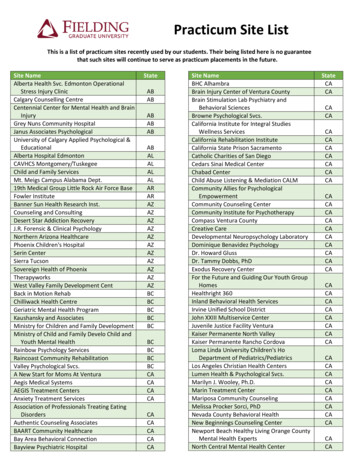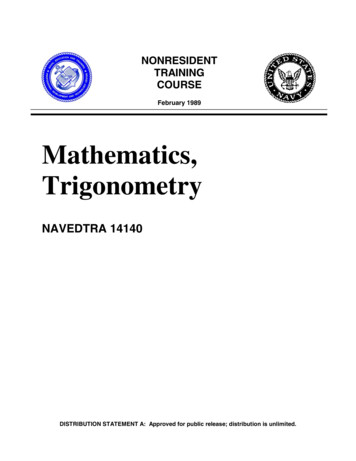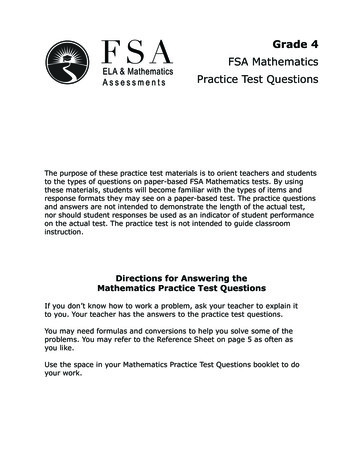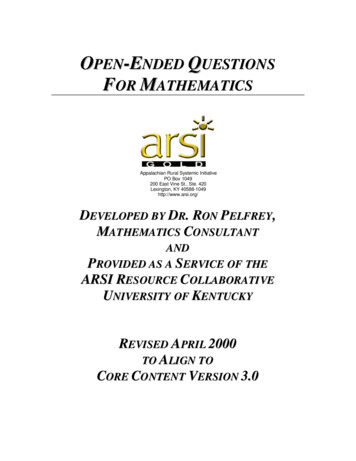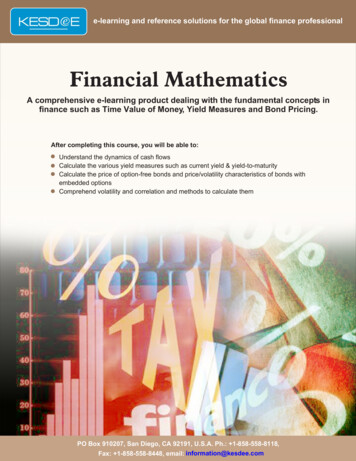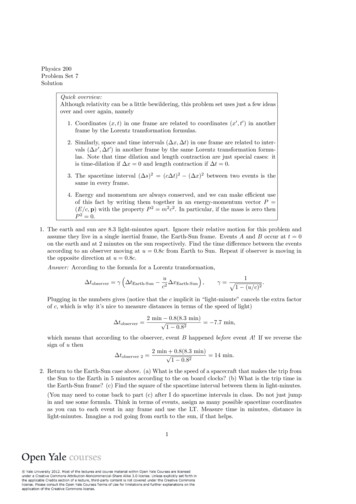
Transcription
Physics 200Problem Set 7SolutionQuick overview:Although relativity can be a little bewildering, this problem set uses just a few ideasover and over again, namely1. Coordinates (x, t) in one frame are related to coordinates (x0 , t0 ) in anotherframe by the Lorentz transformation formulas.2. Similarly, space and time intervals ( x, t) in one frame are related to intervals ( x0 , t0 ) in another frame by the same Lorentz transformation formulas. Note that time dilation and length contraction are just special cases: itis time-dilation if x 0 and length contraction if t 0.3. The spacetime interval ( s)2 (c t)2 ( x)2 between two events is thesame in every frame.4. Energy and momentum are always conserved, and we can make efficient useof this fact by writing them together in an energy-momentum vector P (E/c, p) with the property P 2 m2 c2 . In particular, if the mass is zero thenP 2 0.1. The earth and sun are 8.3 light-minutes apart. Ignore their relative motion for this problem andassume they live in a single inertial frame, the Earth-Sun frame. Events A and B occur at t 0on the earth and at 2 minutes on the sun respectively. Find the time difference between the eventsaccording to an observer moving at u 0.8c from Earth to Sun. Repeat if observer is moving inthe opposite direction at u 0.8c.Answer: According to the formula for a Lorentz transformation, ³1u.γ p tobserver γ tEarth-Sun 2 xEarth-Sun ,c1 (u/c)2Plugging in the numbers gives (notice that the c implicit in “light-minute” cancels the extra factorof c, which is why it’s nice to measure distances in terms of the speed of light) tobserver 2 min 0.8(8.3 min) 7.7 min,1 0.82which means that according to the observer, event B happened before event A! If we reverse thesign of u then2 min 0.8(8.3 min) 14 min. tobserver 2 1 0.822. Return to the Earth-Sun case above. (a) What is the speed of a spacecraft that makes the trip fromthe Sun to the Earth in 5 minutes according to the on board clocks? (b) What is the trip time inthe Earth-Sun frame? (c) Find the square of the spacetime interval between them in light-minutes.(You may need to come back to part (c) after I do spacetime intervals in class. Do not just jumpin and use some formula. Think in terms of events, assign as many possible spacetime coordinatesas you can to each event in any frame and use the LT. Measure time in minutes, distance inlight-minutes. Imagine a rod going from earth to the sun, if that helps.1
Note that the spatial coordinate difference between events in the spacecraft frame are not the sameas the distance between Earth and Sun in that frame. Even pre-Einstein, if I sit in my car goingat 60 mph, I leave New Haven at t 0 (Event 1) and arrive at Boston at t 2 hrs (Event 2), thetwo events have the same coordinate in my frame (i.e., where I am in the car), x 0, but thatis not the distance between these towns.)Answer:(a) According to an observer on the spacecraft, xobserver 0. So we can write (this is nothingbut the time dilation formula, if you look carefully) xEarth-Sun γ(0 v tobserver ) xEarth-Sunvc, vγ p p2 tobserver1 (v/c)(c/v)2 1and solving for v gives""¶2 # 1/2µµ¶2 # 1/2 tobserver5 min8 (3 10 m/s) 1 v c 1 2.6 108 m/s. xEarth-Sun /c8.3 min(b) In the Earth-Sun frame tEarth-Sun 8.3 light-minutes xEarth-Sun 9.6 min.v2.6 108 m/sAlternatively, we can use the time-dilation formula to get (the difference is due to roundingerrors) tobserver5 min 9.7 min. tEarth-Sun p rh2¡ 5 min 2 i 11 (v/c)1 1 8.3 minNote that we can use the “regular” time-dilation formula because, in effect, there is only oneclock on the spacecraft. Before, we had to worry about two different times at two differentlocations, which is why we had to use the full Lorentz transformation.(c) Since the spacetime interval is the same in every frame, we can choose a frame where it canbe most easily evaluated, for example in the frame where x 0. This is true on board thespacecraft, and we already know what the time on board is, so22( s)2 (c tobserver )2 (c · 5 min)2 25 (light-minutes) 9 104 (light-seconds)Let’s check that our calculations are correct by doing the same in the Earth-Sun frame:2( s)2 (c tEarth-Sun )2 ( xEarth-sun )2 (c·9.7 min)2 (8.3 light-minutes)2 25 (light-minutes) ,which agrees with the previous answer, as expected.3. A muon has a lifetime of 2 10 6 s in its rest frame. It is created 100 km above the earth andmoves towards it at a speed of 2.97 108 m/s. At what altitude does it decay? According to themuon, how far did it travel in its brief life?pAnswer: The time dilation factor is γ 1/ 1 (v/c)2 , and the muon’s lifetime τ in its rest framecorresponds to γτ in the laboratory frame. This means the muon travels a distance vγτ , ord vγτ (2.97 108 m/s)(2 10 6 s)r 4.2 km ³1 2.97 108 m/s3 108 m/s22
before it decays, which occurs at 95.8 km above the ground. According to the muon, it has onlytraveledd vτ (2.97 108 m/s)(2 10 6 s) 590 m.γ4. An observer S who lives on the x-axis sees a flash of red light at x 1210 m, then after 4.96 µs,a flash of blue at x 480 m. Use subscripts R and B to label the coordinates of the events.(i) What is the velocity relative to S of an observer S 0 who records the events as occurring atthe same place?(ii) Which event occurs first according to S 0 and what is the measured time interval betweenthese flashes? For the former you do not need to do a calculation. For the latter I suggestusing the spacetime interval.Answer:(i) Physically, what happens is that the observer sees the flash of red, then travels at velocity vsuch that he arrives just in time to see the flash of blue. So without thinking too hard we cansayxR vtR xB vtB ,orv 1210 m 480 mxR xB 1.47 108 m/s.tR tB0 4.96 10 6 s(ii) We have found in part (i) an observer who can travel from one event to the other at v c,and since the spacecraft is as good a signal as any, from what we learned in class the orderof the events must be the same in every frame. Therefore the observer in S 0 sees event Rhappen before event B. To find the time interval in S 0 , we can use the invariant spacetimeinterval and use the fact that the events occur at the same place in S 0 :(c t0 )2 ( x0 )2 (c t0 )2 (c t)2 ( x)2 .Therefores t0 ( t)2 µ xcs¶2 µ(4.96 10 6 s)2 1210 m 480 m3 108 m/s¶2 4.32 µs.In case you are suspicious, we can do this explicitly, using the value of v found above:· ³ 1.47 108 m/s1v0 (1210m) 2.27 µs,t0R γ tR 2 xR r 2³c(3 108 m/s)21.47 108 m/s1 3 108 m/s· ³ 1.47 108 m/s1v 60rtB γ tR 2 xR 4.96 10 s (3 108 m/s)2 (480 m) 6.59 µs.³c8 m/s 21 1.47 103 108 m/sAgain, event R occurs before event B, and the time interval between these flashes is t0 t0B t0R 4.32 µs.3
5. Two rockets of rest length L0 are approaching the earth from opposite directions at velocities c/2.How long does one of them appear to the other?Answer: Let’s pick one rocket (call it rocket 1) and consider how fast the other rocket (rocket 2)looks in this frame. In the Earth frame, rocket 1 has velocity c/2 and rocket 2 has velocity c/2.Applying the velocity addition law givesv20 ( c/2) (c/2)4v2 v1 c,221 v1 v2 /c1 (c/2)( c/2)/c5i.e., rocket 2 looks like it is approaching at 54 c. Applying the Lorentz contraction formula givessµ ¶234L00 L0 1 L0 .L γ556. A body quadruples its momentum when its speed doubles. What was the initial speed in units ofc, i.e., what was u/c?Answer: With f standing for final, i for initial, and vf 2vi , we haveγf mvf2γfpf1 (vi /c)2 4 4,piγi mviγi1 (2vi /c)2after writing out the γ’s and squaring both sides. Solving for vi /c gives1vi .c57. A body of rest mass m0 moving at speed v collides with and sticks to an identical body at rest.What is the mass and momentum of the final clump?Answer:The energy-momentum vector of the moving mass is P1 (γm0 c, γm0 v) where γ p1/ 1 (v/c)2 , while for the mass at rest it is P2 (m0 c, 0). Thus the total energy-momentumvector of the final clump is P P1 P2 . We can read off the momentum as γm0 v, and for themassP 2 M 2 c2 (P1 P2 )2 P12 2P1 · P2 P22 m20 c2 2γm20 c2 m20 c2 2m20 c2 (1 γ),so thatM m0p2(1 γ).8. A body of rest mass m0 moving at speed v approaches an identical body at rest. Find V , the speedof a frame in which the total momentum is zero. Do this first by the law of composition of velocitiesstarting with how you would do this non-relativistically. Next, repeat using the transformation lawfor the components of the energy-momentum vector. (You may need to come back to the secondpart after I do energy-momentum vectors in class.)Answer (see also the solution to Problem 11): First we use velocity addition. You should convinceyourself that if two identical particles have equal and opposite velocities they have equal andopposite momenta, in both the classical case where p mv and in the relativistic case wherep γmv. So we will look for a frame where the velocities are equal and opposite. In a framemoving at velocity V with respect to the original frame, the body at rest has velocity V , whilethe mass that was already moving at v has velocityv0 v V1 vV /c24
with respect to the new frame. If the total momentum is zero, thenv V V ṽ Ṽ 2 2Ṽ ṽ 0,1 vV /c2where we have let ṽ v/c and Ṽ V /c (basically, set c 1 temporarily) in order not to makethe solution look more complicated than it is. Note that this is the relativistic generalization ofthe equation v V V for equal masses. In any case, the quadratic equation gives p1³1 1 ṽ 2 .Ṽ ṽIt’s clear that the solution with a plus sign makes Ṽ larger than 1 (never true) for ṽ 1 (alwaystrue), so we must take the solution with a minus sign. Moreover, we can actually rewrite this in anice way if we let11, γ p21 ṽ 21 (v/c)so thatṼ ṽ1 ṽ 21γ ṽ1 1 1γ1γ2 ṽ ³1 γ11 ³ ṽ111 1 γ1 γorV v1γ ṽγ,1 γγ.1 γNext, we use the energy-momentum vector. In the poriginal frame, the energy-momentum vectorof the moving mass is (γm0 c, γm0 v) where γ 1/ 1 (v/c)2 , while for the mass at rest it is(m0 c, 0). Thus the total energy-momentum vector is P (m0 c(1 γ), γm0 v). In the frame withzero total momentum we must have P 0 (E/c, 0), so if we write out the transformation law forthe momentum part of this vector we have0 γm0 v Vc [m0 c(1 γ)]p γm0 v m0 V (1 γ).1 (V /c)2Solving for V is a simple matter, givingV vγ,1 γwhich agrees with our answer above. The second method is clearly the better method, however.At this point it is also good to check that our answer is reasonable in the non-relativistic limit,i.e., when γ ' 1. Then V v/2, which is what we would have obtained without relativity.9. Show that a photon cannot break up into an electron and a positron. For our purposes theelectron and positron are identical particleswith four-momenta (with c 1) P1 m0 (γ1 , γ1 v1 ) and P2 m0 (γ2 , γ2 v2 ) where γ 1/ 1 v 2 . The photon four-momentum is K (ω, k) withω k . I suggest you use energy-momentum conservation and the dot products of four vectors toshow that this process is kinematically forbidden.Answer: The conservation of energy-momentum tells us K P1 P2 , so if we square both sideswe get¶µE1 E2 p·p m20 c2 ,K 2 0 (P1 P2 )2 P12 2P1 · P2 P22 m20 c2 212c25
which would implyp1 · p2 m20 c2 E1 E2.c cBut this is impossible, because the formulaµ ¶2E p2 m2 c2cwhich holds for all particles tells us p1 E1 /c and p2 E2 /c for particles with mass. Thereforethis process is forbidden by relativity.10. In this problem let c 1. A particle of rest mass m0 decays at rest into a photon and losesδ) in the particle’s restrest mass δ in the bargain. Show that the photon energy is ν δ(1 2m0frame before the decay. Note that the photon has zero rest mass, that is, the square of its fourmomentum vanishes. The problem can be solved most efficiently if you use four vectors and dotproducts between them, but I do not insist you do. Denote the four vector of the photon byK (ν, k) and that of the particle before and after by P (E, p) and P 0 (E 0 , p0 ).Answer: With the notation given in the problem, the conservation of energy-momentum for thedecay is P K P 0 or P 0 P K. Using the fact that P (m0 , 0) (the particle is initially atrest), we square both sides to getP 02 (m0 δ)2 (P K)2 P 2 2P · K K 2 m20 2P · K m20 2m0 ν.Expanding (m0 δ)2 and canceling the m20 ’s givesµ 2m0 δ δ 2m0 ν ν δ 1 2δ2m0¶.11. Consider a particle of rest mass m0 moving at velocity v in your frame S. Write down expressionsfor the components of its energy momentum vector P (p0 , p1 ) in terms of m0 , v. Now see thisparticle from a frame S 0 moving at velocity u. What will be its velocity w and what will bethe components of P 0 (p00 , p01 ), first in terms of w and then in terms of w written in terms ofu and v? Show that the primed coordinates are related to unprimed ones by the same LorentzTransformation that relates (x0 , x1 ) to (x00 , x01 ).Answer:P (γv m0 c, γv m0 v),1γv p.1 (v/c)2From the formula for the addition of velocities, in S 0 the particle has velocityv uw ,1 vu/c2so thatP 0 (γw m0 c, γw m0 w),1γw p1 (w/c)2(the meaning of the labels on γ should be obvious by now). The expression quickly gets messy ifwe just try to write this in terms of u, v, so we do some algebra first:γw r1 1c21³v u1 vu/c2c2 vuc2 vup 2c4 v 2 u2 c2 v 2 c2 u2(c2 vu)2 c2 (v u)2³1 vu/c2c2 vuvu p p p γu γv 1 2 .c(c2 u2 )(c2 v 2 )1 (u/c)2 1 (v/c)26
Then ³³u up00 γw m0 c γu γv m0 c 2 γv m0 v γu p0 2 p1 ,cc ³³³u vu v uu0p1 γw m0 w γu γv m0 1 2 γu γv m0 v γv m0 c γu p1 p0 ,2c1 vu/cccwhich is precisely how (x0 , x1 ) transforms into (x00 , x01 ).12. (OPTIONAL) Consider two rockets A and B of rest length L0 1 m travelling towards each otherwith a tiny shift in the y-direction so they do not collide, as in part Fig. 1. Each sees the otherapproach it with speed u. According to A, when the tail of B passed the tip of A, a missile wasfired from the tail of A towards B as in part (a) of the figure. It will clearly miss due to lengthcontraction of B as seen by A. But B will see the event as in part (b) of the figure and expect ahit. Who is right? (Ignore the time it takes the missile to hit its target.)It will be most educational to assign spacetime coordinates to five events in each frame: tip of Apasses tip of B (set it to (0, 0) for both), tail of B passes tip of A, missile is fired, tip of B passestail of A and finally tails pass. It will be useful to know that if an event occurs at either end ofeither rockets its spatial coordinates are no-brainers in that rocket frame since the tips are alwaysat x 0, x0 0 and the tails are at x 1 and x0 1. It should also be easy to find timeelapsed between tip of your rocket passing my tip and my tail since I am of unit length and youare moving at speed u. Ditto for tail. As a check of your coordinates you may want to see thatthe spacetime interval between any event and (0, 0) comes out same for both.B(a)AB(b)AFigure 1: The point of view of A is in (a). We think Bwill see it as in (b). But something is wrong since therewas no hit according to A. The three funny lines comingout of the tip of A are supposed to be the missile aimedat B.pAnswer: Let γ 1/ 1 (u/c)2 . It’s easy to see that the sequence of events is simpler in frameA, so keeping in mind that according to A the other rocket has length L0 /γ and velocity u webegin by writing down the coordinates of the following events:Tip of B passes tip of A: (x, t) (0, 0)Tail of B passes tip of A: (0, L0 /uγ)(M) Missile is fired from tail of A: ( L0 , L0 /uγ)(T) Tip of B passes tail of A: ( L0 , L0 /u)Tail of B passes tail of A: ( L0 , L0 /u L0 /uγ).7
Note that because γ is greater than 1, the missile is fired (M) before the tip of B reaches the tailof A (T), and the missile misses rocket B according to A. Knowing that relativity is a consistenttheory of physics, we expect B to conclude the same, but it’s not immediately obvious that thisis the case. So let’s use the Lorentz transformation formulas (recall that B moves at velocity urelative to A)xB γ(xA utA ), ³utB γ tA 2 xActo see what transpires according to B:Tip of A passes tip of B: (0, 0)Tip of A passes tail of B: (L0 , L0 /u)(M) Missile is fired from tail of A: (L0 γL0 , L0 /u γuL0 /c2 )(T) Tail of A passes tip of B: (0, L0 /uγ)Tail of A passes tail of B: (L0 , L0 /u L0 /uγ).These are the same events as above described from the point of view of B. We can now comparethe times when B sees the missile being fired (M) and the tail of A passing the tip of B (T):µ¶γ 2 u2L0L0,γ 2.tM tT uγuγcIt turns out that the quantity in parentheses is always less than 1 if u is not zero and is less thanthe speed of light, which we can see by letting z u/c and writing it as z21 z2 z21 .1 z21 z21 z2The square root in the numerator is always less than 1, so the numerator is always less than thedenominator, i.e., the quantity in parentheses is always less than 1. So we’ve shown that tM isalways less than tT , which in turn shows that according to B, the missile fires (M) before the tailof A passes the tip of B (T). Therefore the missile also misses according to B. The point is thatin B’s frame the tip of A passing the tail of B is not simultaneous with the firing of the missile,and in fact occurs after the missile is fired. Strange, but true.Since both observers agree that the missile misses the rocket, in fact both are right: they agreethat the missile misses.8
before it decays, which occurs at 95.8 km above the ground. According to the muon, it has only traveled d v¿ (2:97 108 m s)(2 10¡6 s) 590 m: 4. An observer S who lives on the x-axis sees a ash of red light at x 1210 m, then after 4:96 „s, a ash of blue at x 480 m. Use subscripts R and B to label the coordinates of the events. (i) What is the velocity relative to S of an .



